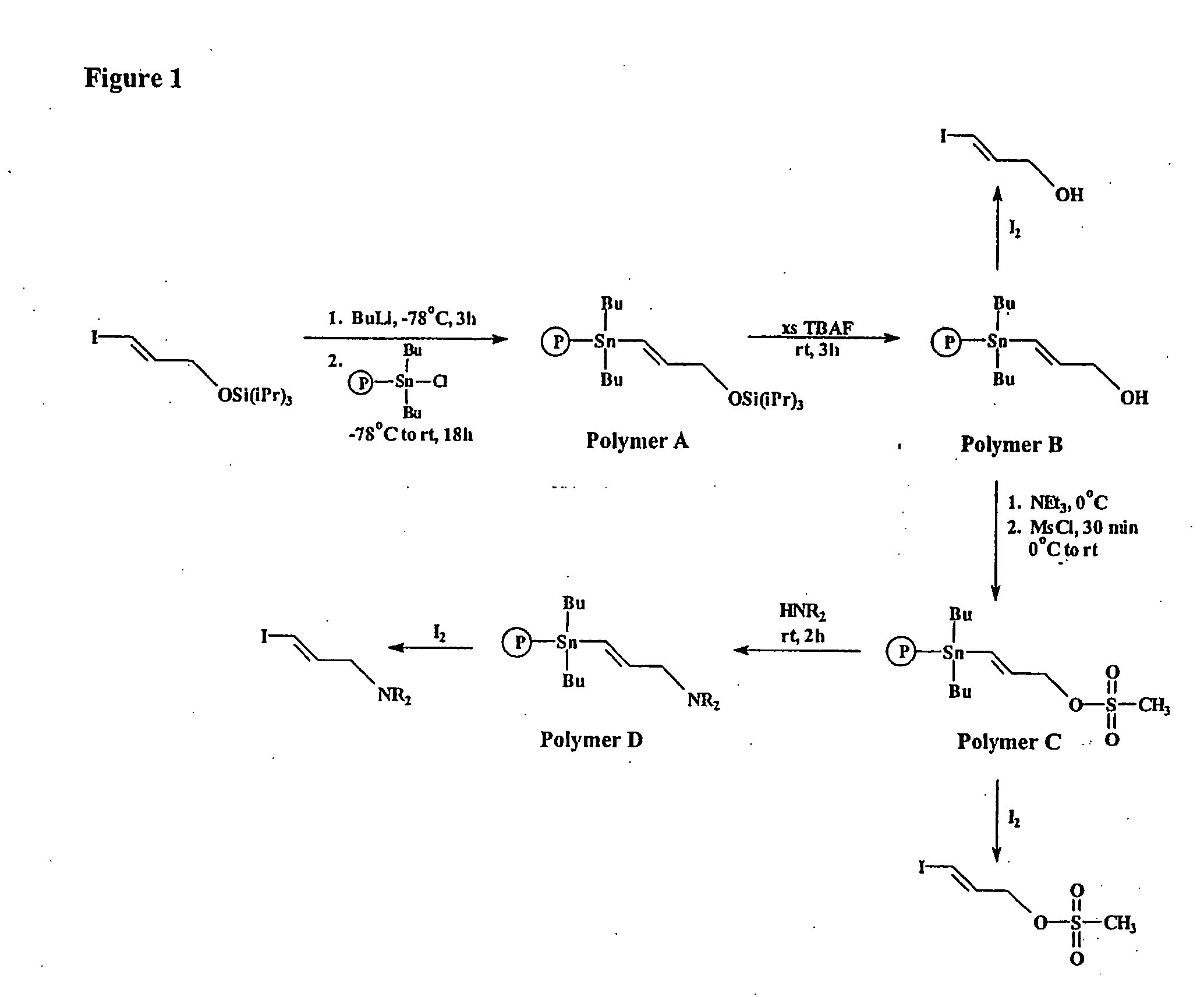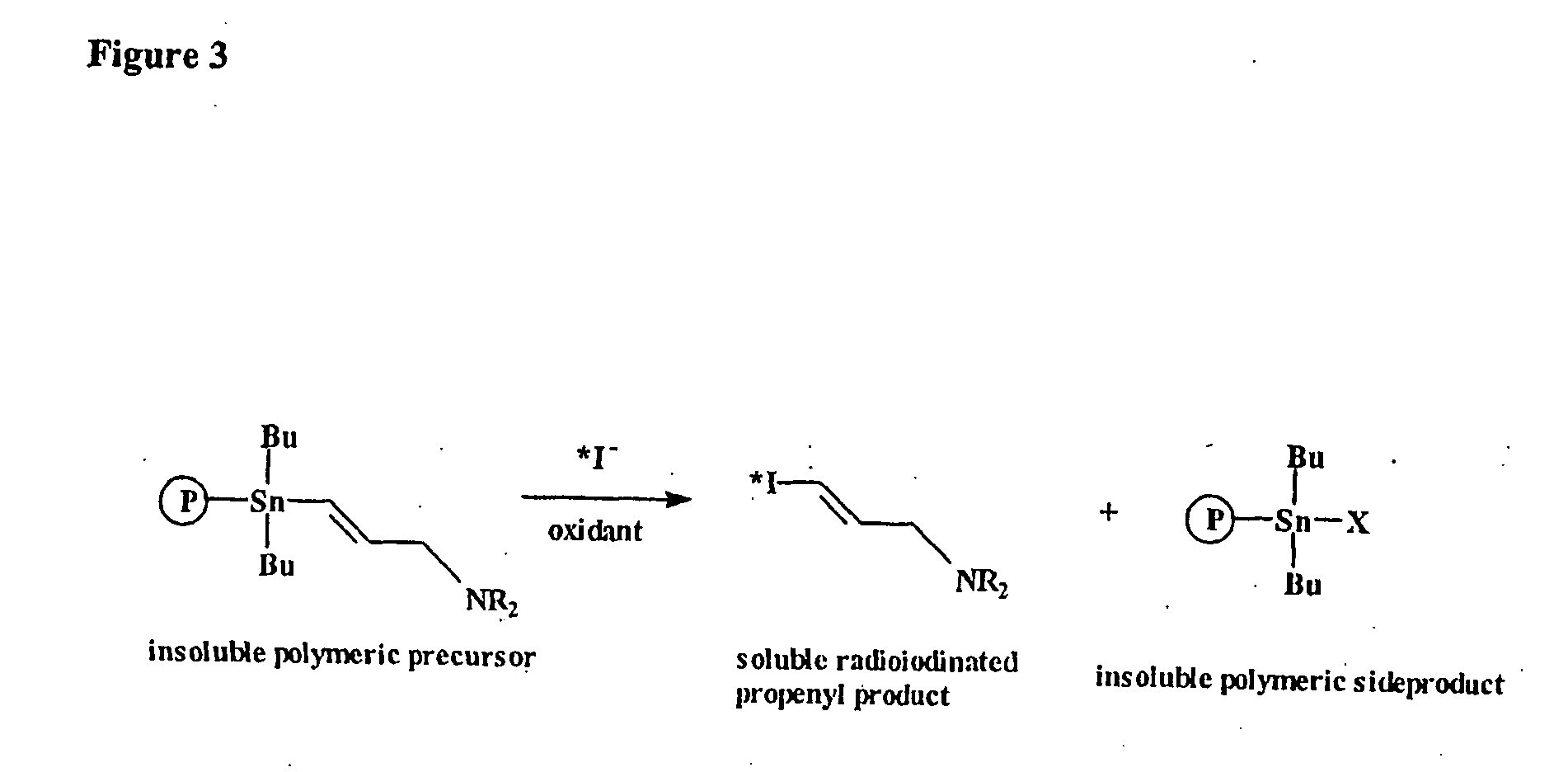Prosthetic groups useful in the synthesis of radiopharmaceutical compounds
a radiopharmaceutical compound and prosthetic group technology, applied in the direction of group 3/13 element organic compounds, drug compositions, therapy, etc., can solve the problems of short shelf life, toxic tin by-products often remain and must be separated, and the radioactive isotope is bound to the delivery molecul
- Summary
- Abstract
- Description
- Claims
- Application Information
AI Technical Summary
Benefits of technology
Problems solved by technology
Method used
Image
Examples
example 1
Coupling 2-Aminobenzophenone-Linker Complex to Solid Support
[0210] To a 30 mL peptide reaction flask was added 4-(4-(5-chloro-2-fluorenylmethoxycarbonylamino-benzoyl)-phenoxymethyl)phen oxyacetic acid (1.52 g, 2.4 mmol, 2.0 equivalents), aminomethyl resin (1.99 g, 1.19 mmol of 1% crosslinked divinylbenzene-styrene, 100 mesh size, substitution level 0.60 milliequivalents / g), and hydroxybenzotriazole monohydrate (0.808 g, 5.28 mmol, 4.4 equivalents). Anhydrous DMF (12 mL) was added to the flask and the mixture was vortexed for 0.5 hour to fully solvate the resin. Diisopropylcarbodiimide (808 mg, 5.28 mmol, 4.4 equivalents) was added by syringe. The reaction flask was stoppered and then vortexed for 24 hours at which point the ninhydrin test on approximately 10 mg of the solid support demonstrated that coupling was complete. The solvent and reagents were filtered away from the solid support and the support was rinsed five times with 20 mL DMF and five times with 20 mL CH2Cl2 (for each...
example 2
General Procedure for Preparation of Polymer-Bound Arylstannane
[0212] A protected haloarylaldehyde (1.5 mol equiv.) was added into a three-necked round-bottom flask, equipped with a T-bore stopcock, a rubber septum and a powder addition side arm containing of chlorostannane polymer (1.5 mol equiv. of SnCl). Under a flow of argon, freshly distilled dry THF was added by syringe. The flask and its contents were outgased three times at dry ice / acetone temperatures and an argon atmosphere was introduced. To the solution of haloarylaldehyde in THF at −78° C., n-butyllithium (1.3 mol equiv., 2.5 M) was added dropwise with the resultant formation of a yellow color. After 2 h at −78° C., the polymer was tipped into the THF solution, and the suspension was allowed to stir for 18 h and warm slowly to RT. Methanol was added to the suspension, and the suspension was filtered. The solid was washed with methanol, water, methanol / water / acetone, methanol / acetone and methanol several times.
Poly-(4S...
example 3
Purification of Benzamides from Iodinolysis
[0236] To approximately 4 mg of poly-(4-{dibutyl[2-(3-and 4-vinylphenyl)ethyl]stannyl}4-(2-aminoethyl)morphobenzamidyl)-co-divinylbenzene in a 25 mL vial was added ˜2 mL of CH3CN and ˜1 mL of 0.1M I2 / CH3CN. After shaking this suspension for 2 h, sufficient 0.2 M sodium thiosulfate was added to discharge the iodine colour. The resultant reaction mixture was then diluted four fold using equal volumes of methanol and 1M NaOH. About 2 mL of this solution was passed through a reverse phase C-18 SepPak (Adsorbex RP-18 (100 mg)). An HPLC analysis of this solution showed one peak consistent with 4-iodobenzaldehyde. The C-18 SepPak column was then washed with about 2 mL of water. HPLC trace of this solution showed one peak, 4-iodobenzoic acid. A wash with about 2 mL of ethanol produced a solution which upon HPLC analysis showed one peak, 4-iodo-N-(2-morpholin-4-ylethyl)benzamide.
PUM
| Property | Measurement | Unit |
|---|---|---|
| atomic number | aaaaa | aaaaa |
| atomic number | aaaaa | aaaaa |
| atomic number | aaaaa | aaaaa |
Abstract
Description
Claims
Application Information
 Login to View More
Login to View More - R&D
- Intellectual Property
- Life Sciences
- Materials
- Tech Scout
- Unparalleled Data Quality
- Higher Quality Content
- 60% Fewer Hallucinations
Browse by: Latest US Patents, China's latest patents, Technical Efficacy Thesaurus, Application Domain, Technology Topic, Popular Technical Reports.
© 2025 PatSnap. All rights reserved.Legal|Privacy policy|Modern Slavery Act Transparency Statement|Sitemap|About US| Contact US: help@patsnap.com



